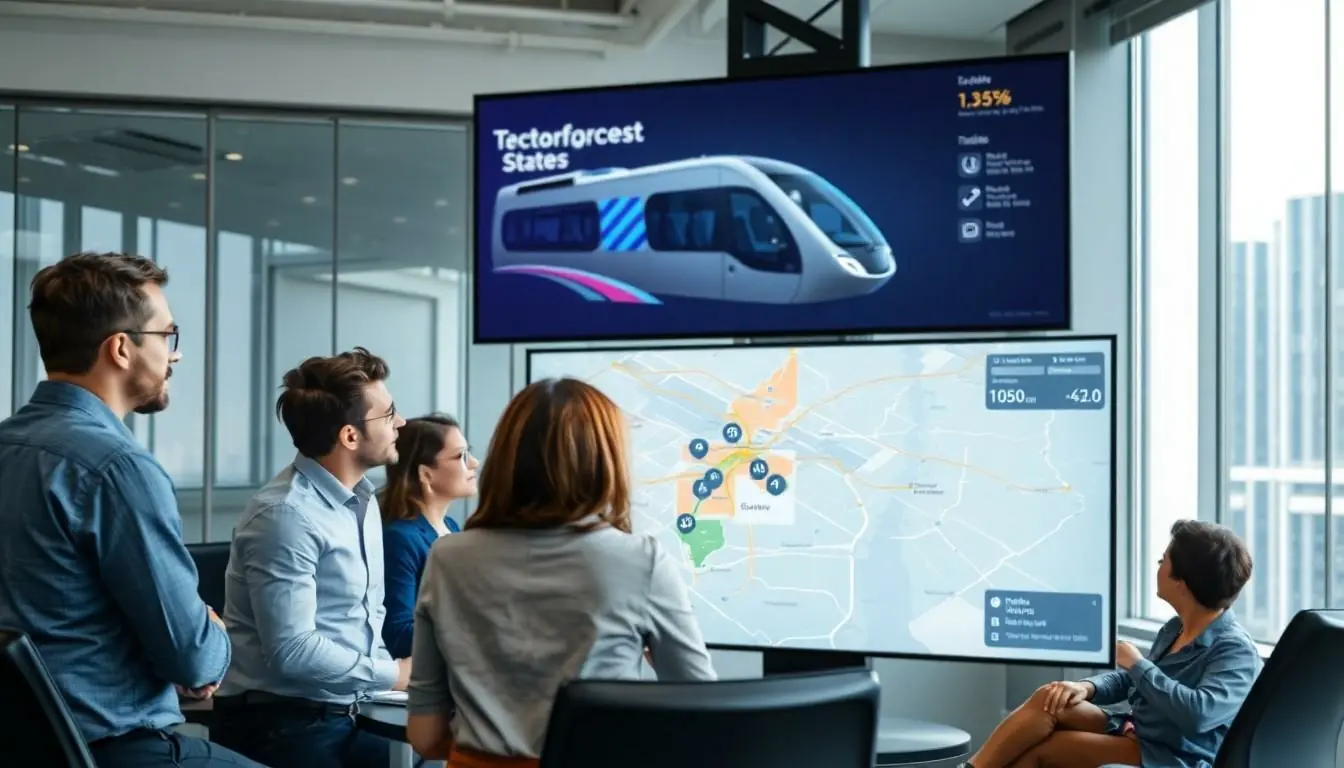Table of Contents
ToggleIn a world where traffic jams seem to have a personal vendetta against commuters, transportation software development emerges as the superhero we didn’t know we needed. It’s not just about getting from point A to point B; it’s about transforming the journey into an experience that’s smoother than a well-oiled machine. With innovative solutions sprouting up faster than potholes on the highway, companies are racing to create software that enhances efficiency and keeps passengers happy.
Imagine a future where ride-sharing apps anticipate your coffee cravings and public transit systems run like clockwork. That’s the magic of transportation software development. As technology evolves, so do the possibilities for optimizing logistics, improving safety, and reducing costs. Buckle up as we dive into the exciting world of transportation software and discover how it’s paving the way for a smarter, more connected future.
Overview of Transportation Software Development
Transportation software development encompasses a variety of applications designed to improve logistics, enhance passenger experiences, and streamline operations. This field includes ride-sharing platforms, fleet management systems, and public transportation applications. Each solution plays a crucial role in creating a more efficient and user-friendly transportation ecosystem.
Technology advancements lead to innovations that facilitate real-time tracking of vehicles and optimize route planning. For instance, GPS integration enables users to monitor locations instantly, reducing waiting times significantly. Requirements for improved safety standards influence the design of software that supports emergency response systems and driver alert mechanisms.
Collaborations between tech companies and transportation services drive software development forward. These partnerships foster creativity and innovation, allowing for tailored solutions that address specific sector challenges. Examples include customized applications that cater to urban planners’ needs or those of logistics companies.
Integration of data analytics within transportation software offers valuable insights into performance metrics. Such analytics guide decision-making, enabling companies to identify inefficiencies and improve service offerings. With this data-driven approach, organizations can adapt to changing user preferences and market demands.
Security considerations remain paramount in transportation software development. Developers prioritize user data protection, employing encryption and secure access protocols to enhance trust. Adhering to regulations also ensures that software maintains compliance standards across different regions.
Overall, this development sector forms the backbone of modern transportation strategies, bridging the gap between traditional methods and future innovations. The shift towards smarter, connected solutions illustrates the potential for enhanced efficiency and reduced operational costs, paving the way for transformative changes in the industry.
Key Features of Transportation Software

Transportation software includes essential features that enhance operational efficiency and user experience. Three key aspects stand out: route optimization, real-time tracking, and fleet management.
Route Optimization
Route optimization significantly reduces transit times and fuel consumption. Advanced algorithms analyze traffic patterns, weather conditions, and historical data to identify the most efficient paths. Companies can implement these solutions to cut costs and improve delivery schedules. By minimizing idle time, organizations ensure that resources operate at peak efficiency. With refined route planning, passenger experiences improve, leading to increased satisfaction.
Real-Time Tracking
Real-time tracking provides visibility into vehicle locations, enhancing accountability and customer service. Users can access live updates via mobile applications, offering precise arrival times and reducing uncertainty. This feature aids in monitoring fleet performance and identifying delays, enabling quick adjustments to schedules. Moreover, safety standards improve as transportation vendors can respond promptly to incidents. Streamlined operations result from the clear communication established through real-time tracking.
Fleet Management
Fleet management optimizes vehicle utilization and maintenance scheduling. Through comprehensive dashboards, administrators gain insights into vehicle performance and operating costs. Monitoring fuel consumption and mileage allows for informed decision-making and better budgeting. Additionally, automated alerts for maintenance needs help prevent breakdowns, keeping vehicles in service longer. Ultimately, efficient fleet management leads to a significant reduction in operational expenses and increases overall reliability.
Importance of Transportation Software in Modern Logistics
Transportation software plays a crucial role in enhancing logistics efficiency. It integrates various operations, enabling seamless coordination among different transport modes. Logistics professionals rely on this software to manage fleets effectively, monitor shipping routes, and optimize delivery schedules.
A significant feature of modern transportation software is real-time tracking. It offers live updates on vehicle locations, keeping customers informed and improving transparency. Enhanced visibility allows for quicker decision-making when delays occur, ensuring that logistics teams can respond effectively to unexpected issues.
Route optimization algorithms contribute significantly to operational efficiency. They minimize fuel consumption and transit times, which increases overall productivity. By employing these advanced algorithms, companies can reduce costs while improving service delivery.
Data analytics within transportation software provides insightful performance metrics. These metrics guide logistics managers in evaluating efficiency and making informed decisions. Adapting to user preferences becomes easier with data-driven insights, further enhancing customer satisfaction.
Safety standards established within transportation software are vital for protecting user data and ensuring secure transactions. Compliance with strict regulations builds trust with customers and stakeholders, which is essential for gaining a competitive edge in the logistics sector.
Collaboration between technology firms and logistics companies fosters continuous innovation. Tailored solutions address specific industry challenges, equipping businesses to meet evolving demands. Ultimately, transportation software development secures the backbone of modern logistics, bridging traditional operations with future advancements.
Challenges in Transportation Software Development
Transportation software development faces various obstacles that can hinder progress. Integrating with existing systems poses a significant challenge for developers aiming for seamless functionality.
Integration with Existing Systems
Legacy systems often require extensive modifications to work alongside new software solutions. Developers struggle to create compatible interfaces that facilitate smooth communication between older and newer platforms. Utilizing APIs can aid in this process, as they enable data exchange and function coordination. Cultural and operational differences between organizations may lead to difficulties in aligning objectives. Lastly, inadequate documentation can complicate integration steps, creating further delays and requiring additional resources.
Ensuring Data Security
Data security remains a primary concern in the development of transportation software. Users expect robust protection of their personal and sensitive information. Implementing strong encryption measures helps to safeguard data against breaches. Compliance with regulations like GDPR or CCPA is crucial to build trust with customers and avoid legal issues. Developers must also conduct regular security audits to identify vulnerabilities. Educating users about data security practices enhances overall safety and awareness.
Future Trends in Transportation Software Development
Innovations in artificial intelligence (AI) significantly enhance transportation software capabilities. AI algorithms provide predictive analytics, leading to improved operational efficiency and reduced costs.
Data integration from multiple sources empowers transportation systems to create more responsive and personalized user experiences. This integration enables software to analyze historical trends and optimize routing, resulting in timely deliveries and improved customer satisfaction.
Automated vehicle technology is shaping the future of transportation software. Companies are increasingly integrating features for self-driving capabilities, revolutionizing logistics and enhancing safety measures.
Sustainable practices are becoming central to development strategies. Transportation software that optimizes fuel efficiency reduces environmental impact while adhering to regulatory standards.
User-friendly interfaces increase accessibility for all demographics. Simplified navigation features will enhance the transit experience, ensuring that real-time information remains easily understandable.
Predictive maintenance applications are gaining traction within fleet management. These applications leverage data analytics to anticipate maintenance needs, minimizing downtime and enhancing overall fleet reliability.
Blockchain technology is emerging as a key player for data security and transparency. Its decentralized nature provides tamper-proof records for transactions, building trust between service providers and users.
Mobile apps continue to evolve, focusing on seamless user engagement. Features such as in-app payments, ride-sharing coordination, and integrated public transport schedules align with the needs of modern commuters.
Collaboration across industries fosters innovative solutions tailored to specific challenges. Partnerships between tech firms and transportation services will drive future advancements, leading to smarter, more efficient systems.
Embracing these trends positions transportation software development at the forefront of industry transformation, ensuring enhanced efficiency, safety, and user satisfaction.
Transportation software development is reshaping how people and goods move across the globe. By leveraging innovative technologies and data analytics, it enhances efficiency and safety while ensuring a better user experience. The ongoing collaboration between tech companies and transportation services is crucial for addressing industry challenges and driving future advancements.
As the landscape evolves, the integration of AI and automation will further streamline operations and improve responsiveness. Prioritizing user data protection and compliance will build trust and foster a more secure environment. With these developments, transportation software is not just a tool; it’s a vital component of a smarter, more connected transportation ecosystem.




